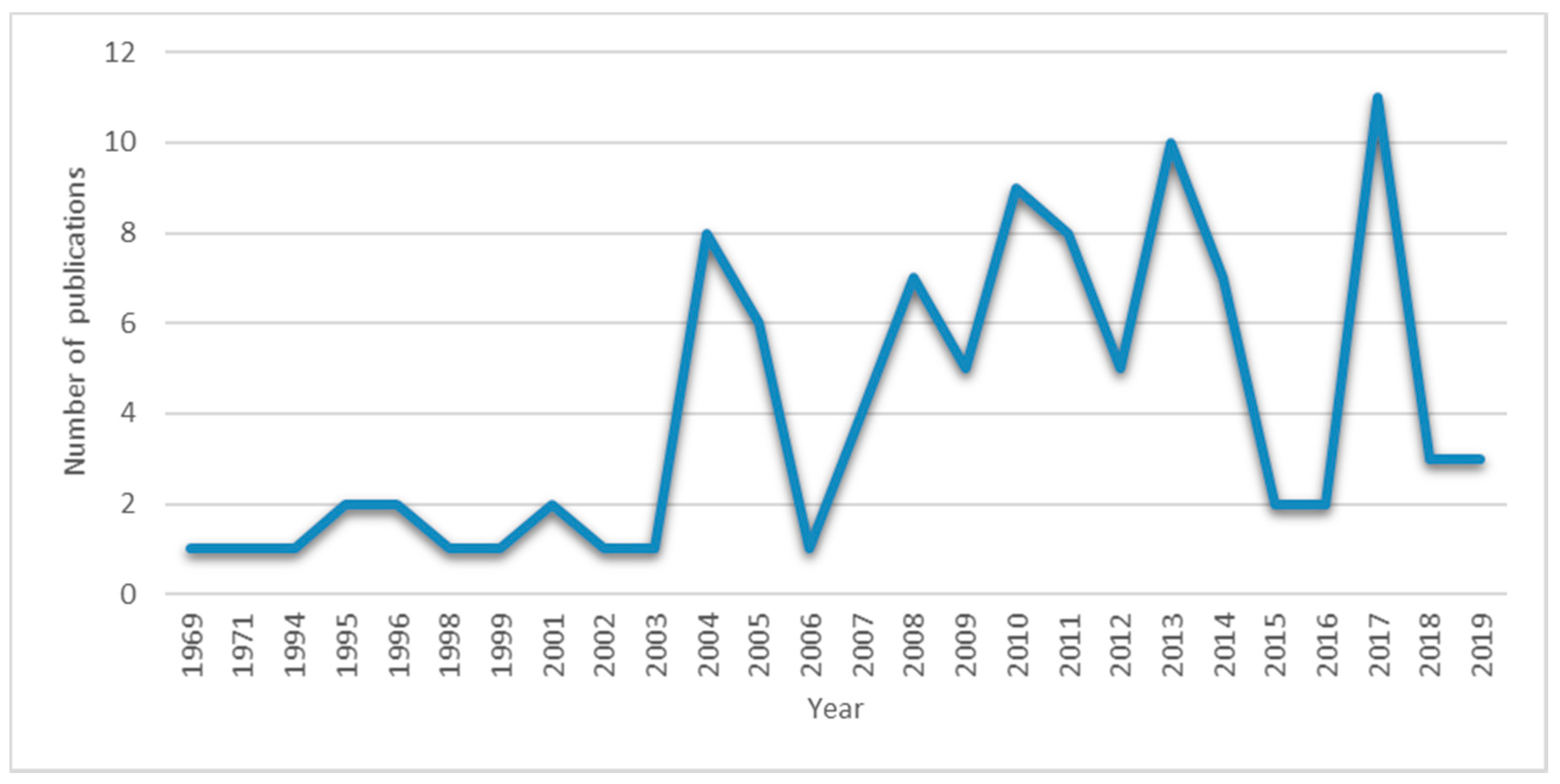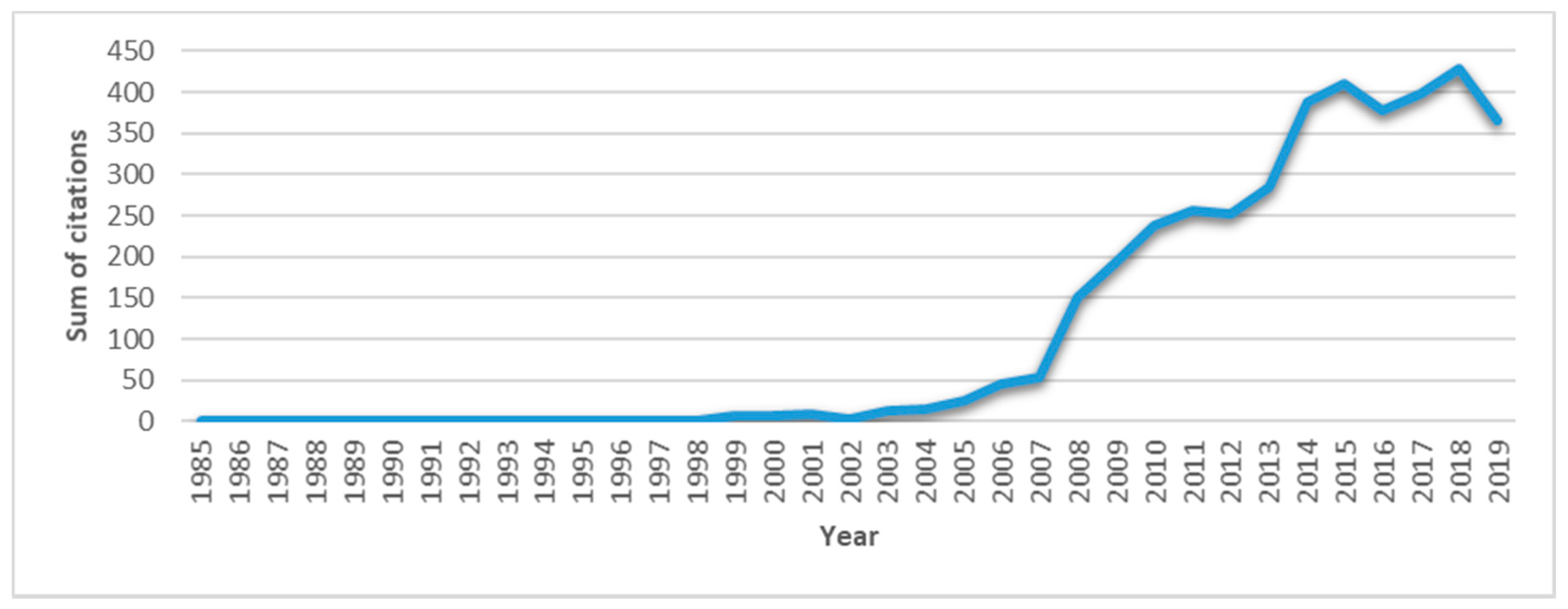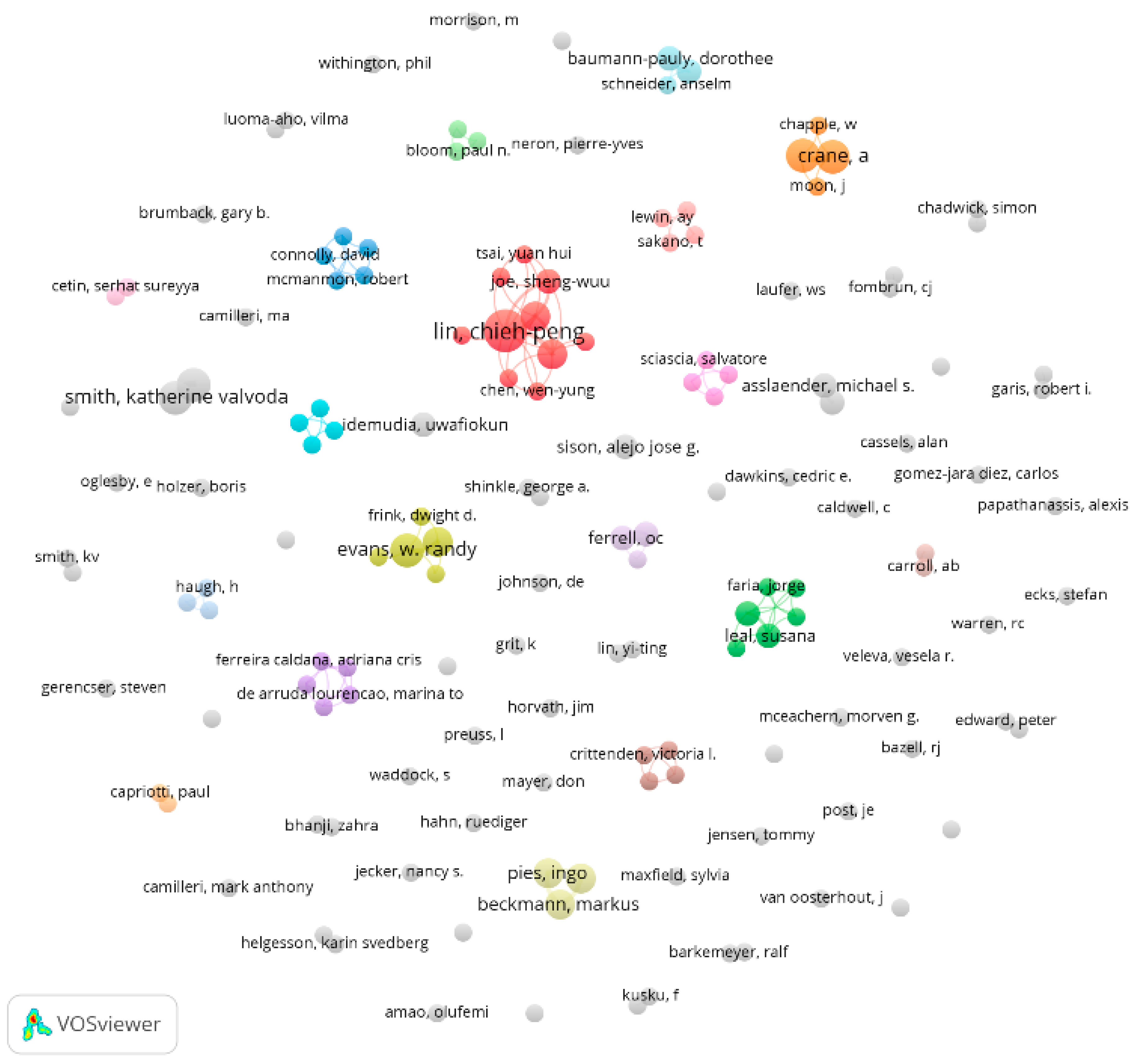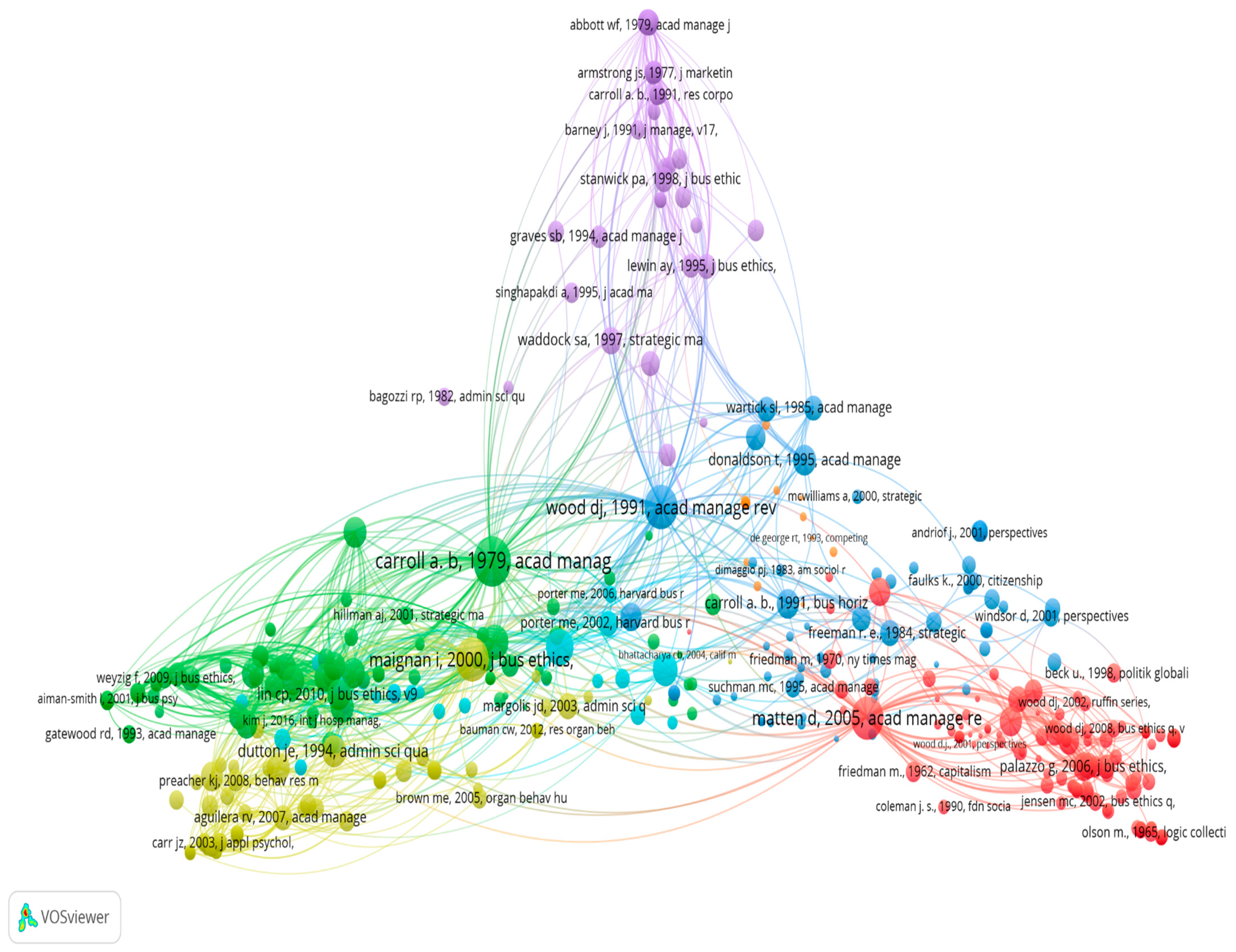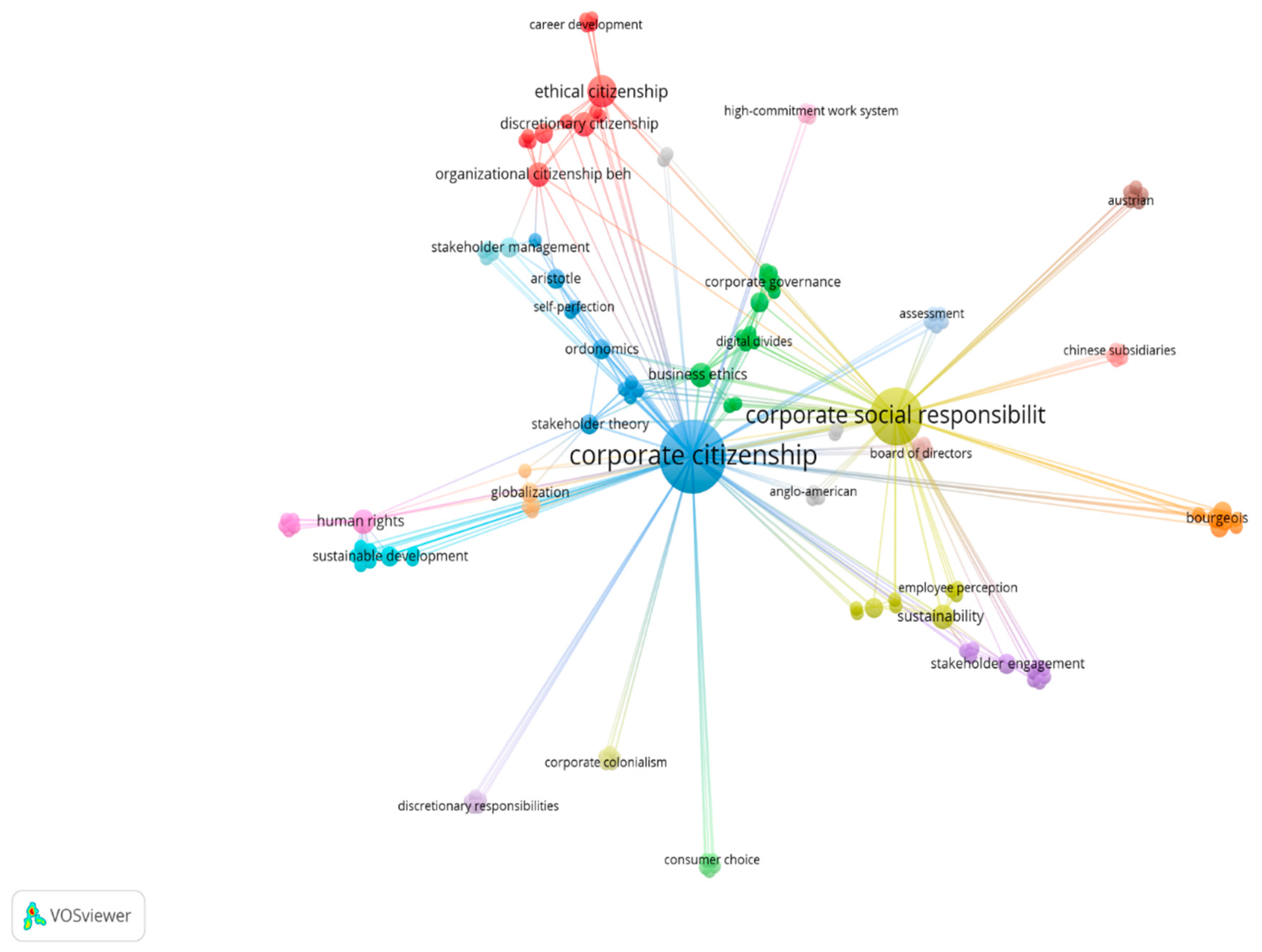1. Introduction
First coined in 1969 [
1] and gaining momentum around 2004 [
2,
3,
4,
5,
6,
7,
8,
9], corporate citizenship (CC) describes the civic behavior of companies. When a company acts like a good citizen, it goes far beyond shareholder interests and the interests of the stakeholders close to the company by addressing society as a whole. It is known that companies such as Bosch or Siemens were already socially involved in the 1920s [
10]. In the United States, this topic became more important in the 1980s [
11]. The creation of the Ron Brown Corporate Citizenship Award by US President Bill Clinton increased public awareness of the concept [
12,
13].
With increasing importance in practice, science has become more concerned with the topic and has produced a large number of publications over the past 50 years, creating a confusing research landscape. Traditionally, in order to structure such a topic, literature reviews are used [
14]. In contrast to this qualitative approach, with today’s technical possibilities, bibliometric analyses are also available as a quantitative and thus objective method. The number of publications and, in particular, citations is considered to provide information about the impact of research [
15].
Against this background, we aim to map the corporate citizenship literature bibliometrically. Specifically, we employ a temporal analysis of publications and citations, analyze the productivity of involved disciplines, analyze the distribution of publication forms, and analyze the impact factors of journals that have published on corporate citizenship. We also conduct an author productivity and citation analysis, an author co-citation analysis, an article citation analysis, an article co-citation analysis, and a keyword co-occurrence analysis.
Our analysis complements recent bibliometric analyses on the related and popular [
16] concept of corporate social responsibility (CSR) [
17,
18,
19,
20,
21,
22,
23] as well as recent CSR literature reviews [
13], which partly focus on interfaces with other fields [
24,
25,
26,
27]. The relationship between corporate citizenship and CSR seems to be rather unclear [
28]. For example, some scholars emphasize differences in their basic elements but suggest that they are basically similar approaches [
29]. According to Camilleri [
30], CSR is characterized by the businesses’ voluntary societal engagement. However, he refers to such behavior as corporate citizenship as well, which suggests an overlapping definition of both concepts. Van Luijk [
31] sees CSR as a concept not natural to firms, therefore provoking a conflict with a firm’s original purpose, i.e., maximizing profits by satisfying customer demands, whereas corporate citizenship stresses that firms are a natural part of society. Corporate citizenship can also be seen as a sub-term of CSR [
32,
33]) with CSR representing a holistic concept of an all-embracing responsibility that addresses every aspect of a firm such as fairness towards suppliers [
34] or striving for employee wellbeing [
35] by, for example, investing in their intellectual capital [
36]. Conversely, corporate citizenship is limited to “charitable donations and other forms of corporate philanthropy undertaken in the local community” [
37]. Finally, corporate citizenship can be interpreted as CSR’s designated successor [
16] as corporate citizenship “was originally meant to emphasize, broaden and redirect specific dimensions of CSR” [
38] (pp. 241]. Either way, despite the overlaps between corporate citizenship and CSR, corporate citizenship seems to have gained the status of a research field in its own right, which makes a bibliometric analysis relevant.
However, research on both concepts—corporate social responsibility and corporate citizenship—largely differs from a bibliometric point of view. While a title search for corporate social responsibility leads to more than 5500 publications, for corporate citizenship only 144 articles can be found (April 2020). Both research streams continue to produce publications.
The paper is structured as follows: starting with the methodology section, we describe in detail the employed bibliometric methods, specifically their function and applicability for the corporate citizenship research field. The usage of different bibliometric methods ensures broader and more detailed results for a research topic with a wide range of interconnected sub-fields. After presenting the results of the analyses, we highlight key interpretations.
Our research contributes to the corporate citizenship, and indirectly, to the CSR literatures by adding a quantitative and objective perspective on published research and therefore mapping the research field.
4. Discussion
From the results of the bibliometric analysis, several conclusions can be drawn. In a temporal perspective, corporate citizenship was first mentioned in 1969, but serious scholarly discourse started to gain momentum in 2004. A reason for the increased interest could be corporate scandals like Enron (2001) or WorldCom (2002). Taking up a stronger ethical focus on the responsibility of corporations and the duration of the research, review, and revision processes might have caused this delay. Even though the annual number of publications since 2004 varies, we see a sharp increase in annual citations until around 2014, with subsequently stagnating citation rates. This could be interpreted as a phase of saturation. It remains to be seen if the last five years represent only an interim phase of consolidation to be followed by further growth or if the research field is in decline. Scholars who aim at high citation rates might tend to focus on the CSR concept in the future. Due to general unpredictability [
82] and especially due to the current COVID-19 economic crisis [
77], it is rather unclear how corporate citizenship and CSR in practice and research will further continue quantitatively. Two scenarios [
83] seem feasible: firms might be forced to cut costs and reduce their social engagement, or we might see stronger societal cohesion and solidarity between citizens and firms, which might result in decreasing or increasing research efforts.
Analysis of disciplines that are involved in corporate citizenship research unsurprisingly shows that the topic is well-established in both business/management and ethics. However, political science and environmental studies also contribute to the field, showing interdisciplinarity. As corporate citizenship is an approach firms can follow voluntarily without any legal obligation, politics might discuss this conceptual split between law and ethics in order to increase firms’ engagement. The involvement of environmental studies shows that corporate citizenship might be extended to the triple bottom line conceptualization [
84] in which, apart from economical, not only social but also environmental issues are represented.
Analysis of the productivity of publication forms showed a clear dominance of business ethics journals, with the
Journal of Business Ethics as the flagship publisher. Not surprisingly, corporate citizenship is therefore clearly a business ethics topic. However, the fact that leading journals such as the
Academy of Management Review also deal with corporate citizenship shows that it is no niche topic but one that is relevant for the broad scope of business and management research. This is also underlined by the fact that 50 papers were published in highly relevant journals with an impact factor above 3. The average impact factor is 4.08, which can be considered quite high in business and management. Interestingly, corporate citizenship is no predominant topic in marketing journals. Therefore, it can be concluded, at least from a scholarly view, that corporate citizenship is not seen as a measure of mere “greenwashing” [
85].
The analysis of co-author productivity shows that a paper has 1.4 authors on average, which is surprisingly low, considering the average number of authors in business and management being clearly above 2 [
86,
87]. Collaborations between co-authors tend to persist, whereas collaborations beyond these small teams hardly exist. A reason for that might be that most papers are conceptual and do not involve complex research designs, which are often related to a higher number of co-authors [
88]. Corporate citizenship research also does not require interdisciplinary collaboration which would possibly increase the number of co-authors [
89]. A practice of questionable co-authorships such as honorary authorships [
90] can probably be precluded for the corporate citizenship field, showing that ethics researchers also behave ethically. Additionally, publish-or-perish pressure also seems to be lower compared to other fields. However, the low average number of co-authors might have a negative effect on the impact of corporate citizenship research, especially when it is measured in citations [
91]. This can also be concluded from the data set as, on average, single-authored papers have smaller citation numbers than multi-authored ones. Among the 40 least-cited publications, 28 (70%) are written by one author. In contrast, most of the highly cited papers were co-authored.
The publications are geographically divided into the United States, followed by Europe and Asia. This coincides with the results on CSR bibliometrics from Welford [
92].
The article citation analysis shows a Pareto-like distribution. A Pareto distribution is a power-law probability distribution originally applied to describe how wealth is distributed in a society, namely that a small proportion of the population holds a large portion of wealth. Such an uneven distribution also applies to citations, where a small number of papers accounts for the multitude of all citations in the field, whereas the majority of papers received only a few citations. Interestingly, the three papers with the highest average citations per year were not published in journals that specifically focus on business ethics but on management in general. Being published in journals with a broader scope and higher impact factor can obviously contribute to an increased attention and promotion of a research field.
The article co-citation analysis showed a strongly interconnected network and somewhat relativizes the picture of isolated research suggested by the co-author analysis. Whereas authors tend to actively collaborate with only a few colleagues, they clearly appreciate other scholars’ work by citing their publications. Additionally, the analysis shows that corporate citizenship publications are often co-cited with publications from other fields, especially CSR. This, again, shows the very close relationship of both research streams.
Finally, the keyword co-occurrence analysis shows the broad scope of related topics corporate citizenship research deals with. Apart from corporate citizenship’s philosophical foundations and, again, CSR, corporate citizenship research touches on other sub-fields in or related to business ethics such as corporate governance, sustainability, and human rights. However, research in the field of human resource management and organization can also be identified, as represented by keywords such as “career expectation,” “organizational citizenship behavior,” “organizational commitment,” and “organizational trust”. Apparently, most of these keywords deal with “work engagement” which itself also appears as a keyword. Corporate citizenship as a specific form of corporate, i.e., collective, behavior can be seen as an influencing factor on individual behavior. More specifically, employees who work in firms that engage in corporate citizenship are expected to show more engagement in their work. This increased commitment could even exceed formal duties, as organizational citizenship behavior research suggests [
93,
94,
95]. However, the line between employees’ additional well-being and firms’ potential to exploit employees and therefore unethical behavior might be thin.
As in all research, our study has several limitations. First, bibliometrics depends on the completeness and quality of the data set. The choice of the database, automatic selection criteria, and manual selection of publications could lead to results that might differ from bibliometric analyses that made different choices. Second, attempts to cluster a research field might suggest a clear distinction of sub-fields. However, this impression should be avoided [
74]. This is also the case in this study, where clusters appear rather fuzzy. Third, when interpreting bibliometrics, researchers should always be aware of the Matthew effect, i.e., frequently cited articles are blindly cited just because they have been cited often already [
96]. For example, for an initial bust in citations, the cronyism effect, which states that scholars preferably cite work of their close colleagues [
96], might be sufficient.
In order to leave the current stagnation phase, corporate citizenship researchers should expand their network of co-authors and intensify their collaboration. Additionally, in order to shift corporate citizenship from the current niche to mainstream research, it is advisable to build conceptual bridges to established topics in business and management research and to publish in major business and management journals. We can already see this happening regarding human resource management and organization studies. However, other domains also seem relevant. For example, it is somewhat surprising that corporate citizenship so far hardly addresses marketing and the right balance between “true” corporate citizenship and mere greenwashing [
85].
5. Conclusions
Research on corporate citizenship has resulted in a rich publication landscape which tends to be complex and fragmented. In order to structure the field quantitatively, we employed bibliometric analyses. Specifically, we conducted a temporal analysis of publications and citations, an analysis of the productivity of involved disciplines, an analysis of the productivity of publication forms including journal impact factors, an author productivity and citation analysis, a co-author analysis, an article citation analysis, an article co-citation analysis, and a keyword co-occurrence analysis.
Our results show that first publications go back to 1969, and research gained momentum in 2004, with a volatile number of annual publications since then. Citations started to rapidly grow in 2007 and have so far reached a plateau since 2014. Therefore, it is unclear if corporate citizenship will leave its current phase of stagnation and will decline or gain momentum again.
Corporate citizenship as a business ethics topic is at the intersection of business/management and ethics. However, political and environmental sciences also conduct research on the concept, showing some interdisciplinarity in the subject.
Publishing about corporate citizenship takes place predominantly in journals, with the Journal of Business Ethics as its main outlet. In general, scholars publish in journals with an average impact factor of more than 4, showing that corporate citizenship research is being published in highly relevant journals.
Authors show a rather low collaboration rate. On average, only 1.4 co-authors publish papers on corporate citizenship, and co-author teams hardly change. This lack of networking impedes the further progress and impact of the research field.
Citations are highly unevenly distributed, showing a Pareto-like distribution, i.e., a small number of publications account for a large share of all citations. The highest citation rates could be achieved by papers published in journals with broader management rather than a more specific scope.
The co-citation analysis relativizes the picture of isolated scholarly work on corporate citizenship. Despite collaborating only to a small extent, authors appreciate other authors’ work and cite their publications. Corporate citizenship publications are often co-cited with CSR publications, which suggests a close proximity between both research fields.
Authors use a multitude of keywords to describe focal points in their research. Philosophical foundations and relations to CSR research, as well as to other business ethic topics, are clearly visible. However, connections to human resource management and organization studies can also be identified, especially regarding the influence of corporate citizenship on work engagement.
